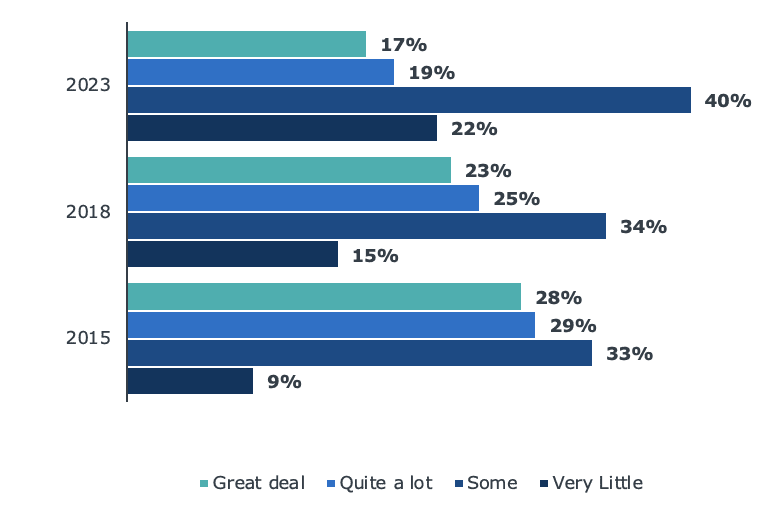Americans’ trust in higher ed has reached a new low. Here’s how to navigate the ongoing confidence crisis.
October 4, 2023, By Chrysanthi Violaris, Analyst, Product Marketing
Gallup’s most recent poll revealed a concerning trend: only 36 percent of Americans have “a great deal” or “quite a lot” of confidence in higher education. This decline is not a new development, with trust steadily eroding over the past eight years. But these stats have gone from intimidating to concerning. What sets this year’s results apart is that, for the first time, a majority of survey respondents expressed a lack of confidence in educational institutions. Gallup suggests the rising cost of education as a driving force in low public confidence. While expert opinions differ on how strongly to attribute low public confidence to the cost of education, higher ed leaders should see these results as a wake-up call and take action to stop this confidence crisis.
Americans’ confidence in higher education continues to fall
Trends in public trust between 2015-2023, Gallup

While it may not be the only factor contributing to declining confidence in higher education, you cannot ignore the impact of the skyrocketing cost of tuition. Jon Fansmith, Senior Vice President for Government Relations at the American Council on Education, stated these results reflect a “concentrated disenchantment” with higher education, which may be fueled by the financial burden it imposes. Moreover, younger generations are increasingly questioning the value of a traditional college degree. Rather than moving from high school to college, students are finding different avenues to create a career without acquiring large student debt. This, however, creates a vicious cycle: as fewer students enroll, institutions raise tuition to compensate for lost revenue, which continues to drive potential students further away from higher education.
The decline in confidence in higher ed has potentially far-reaching consequences, including a significant impact on institutions’ financial bottom lines. As university leaders contend with changing the narrative around the value of higher education, they must also deal with their very real financial needs as well. College and university leaders must explore avenues to offset lost revenue and prioritize cost-containment strategies that allow them to alleviate financial concerns without resorting to tuition increases. When asked to reflect on what’s working for our partners, our researchers identified the following tactics:
Auditing academic programs for efficiency: Auditing resource use within academic departments, schools, or colleges identifies opportunities to reduce costs or reallocate resources from lower to higher-impact activities. Efficiency audits help identify gaps in instructional capacity versus student demand at the course, program, and department levels.
Continuous program improvement: Making sure your institution offers the right mix of academic programs is crucial for staying competitive while achieving your financial priorities. Most academic program review processes are lengthy and occur once every few years. Build a culture of regular program review that emphasizes continuous improvement to get a more reliable sense of academic program health and opportunities. Continuous review enables academic leaders to look at overall portfolio health, enabling better decision-making and a clearer allocation of limited financial resources while engaging academic deans.
Meeting today’s student demand with alternative programs: Stackable certificates, micro-credentials, and many other alternative offerings are evolving quickly and engaging a growing share of both undergraduate and graduate learners. Aligning your portfolio to market needs and student interest through alternative programs helps build new revenue at your institution.
Elevate the student experience to improve overall retention: Current students can also fall victim to the treacherous tuition cycle, leading to stopouts. Focusing efforts on supporting the student experience and student success helps retain those students, ultimately easing constrained institutional finances. For example, student-centered advising increases student achievement and positively impacts overall retention.
Interested in learning about how EAB can help your institution build lasting financial resilience? Visit our Strategic Advisory Services page to learn more.

More Blogs

3 assumptions that derail higher ed strategic planning—and how to fix them

How your university can better anticipate the future
